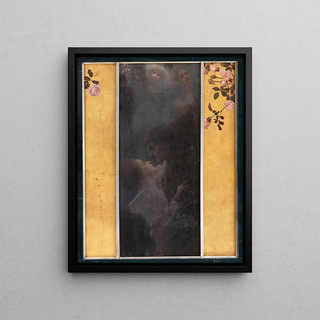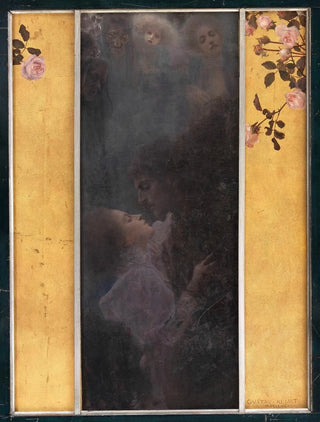Art print | Love - Gustav Klimt


View from behind

Frame (optional)
Gustav Klimt's "Love" artwork embodies a masterful fusion of sensuality and symbolism, transporting viewers into a universe where emotion and aesthetics converge. This painting, with its flowing curves and shimmering colors, evokes deep and universal feelings such as love and passion. Klimt, a prominent figure of the Art Nouveau movement, succeeds in capturing not only physical beauty but also the very essence of human relationships through his bold compositions. The art print "Love" by Gustav Klimt allows this artistic richness to enrich any space, offering an invitation to contemplation and daydreaming.
Style and uniqueness of the work
Klimt's style is immediately recognizable, and "Love" is no exception. The use of ornamental motifs and vibrant colors creates an enchanting, almost mystical atmosphere. The figures are often enveloped in golden patterns and delicate textures, giving the work a captivating tactile and visual dimension. In "Love," the characters are depicted in a tender embrace, their bodies intertwined with a harmony that suggests the fluidity of emotions. The contrast between the richly decorated background and the human figures emphasizes the depth of shared intimacy, while highlighting the complexity of romantic feelings. This piece perfectly illustrates Klimt's ability to blend sensuality and spirituality, creating a dialogue between body and soul.
The artist and his influence
Gustav Klimt, born in Vienna in 1862, is one of the most influential artists of the early 20th century. His work, often marked by themes of femininity and sexuality, challenged the conventions of his time. Klimt established himself as a pioneer of symbolism, using decorative elements to enrich his compositions. His influence extends far beyond his era, inspiring many contemporary artists and artistic movements. Klimt's works are often seen as a celebration of beauty and love, but also as a reflection on the human condition. "Love" is a perfect illustration of this duality, where art becomes a means to explore

Matte finish

View from behind

Frame (optional)
Gustav Klimt's "Love" artwork embodies a masterful fusion of sensuality and symbolism, transporting viewers into a universe where emotion and aesthetics converge. This painting, with its flowing curves and shimmering colors, evokes deep and universal feelings such as love and passion. Klimt, a prominent figure of the Art Nouveau movement, succeeds in capturing not only physical beauty but also the very essence of human relationships through his bold compositions. The art print "Love" by Gustav Klimt allows this artistic richness to enrich any space, offering an invitation to contemplation and daydreaming.
Style and uniqueness of the work
Klimt's style is immediately recognizable, and "Love" is no exception. The use of ornamental motifs and vibrant colors creates an enchanting, almost mystical atmosphere. The figures are often enveloped in golden patterns and delicate textures, giving the work a captivating tactile and visual dimension. In "Love," the characters are depicted in a tender embrace, their bodies intertwined with a harmony that suggests the fluidity of emotions. The contrast between the richly decorated background and the human figures emphasizes the depth of shared intimacy, while highlighting the complexity of romantic feelings. This piece perfectly illustrates Klimt's ability to blend sensuality and spirituality, creating a dialogue between body and soul.
The artist and his influence
Gustav Klimt, born in Vienna in 1862, is one of the most influential artists of the early 20th century. His work, often marked by themes of femininity and sexuality, challenged the conventions of his time. Klimt established himself as a pioneer of symbolism, using decorative elements to enrich his compositions. His influence extends far beyond his era, inspiring many contemporary artists and artistic movements. Klimt's works are often seen as a celebration of beauty and love, but also as a reflection on the human condition. "Love" is a perfect illustration of this duality, where art becomes a means to explore






